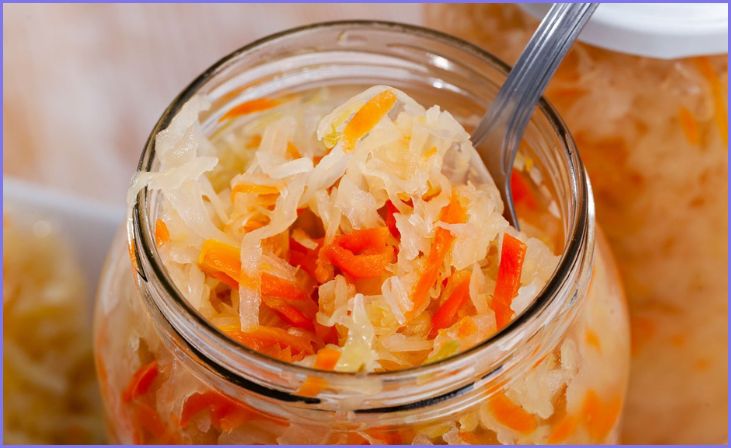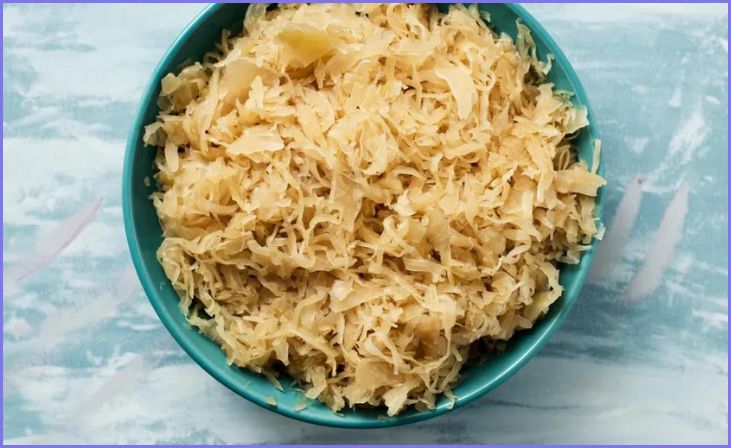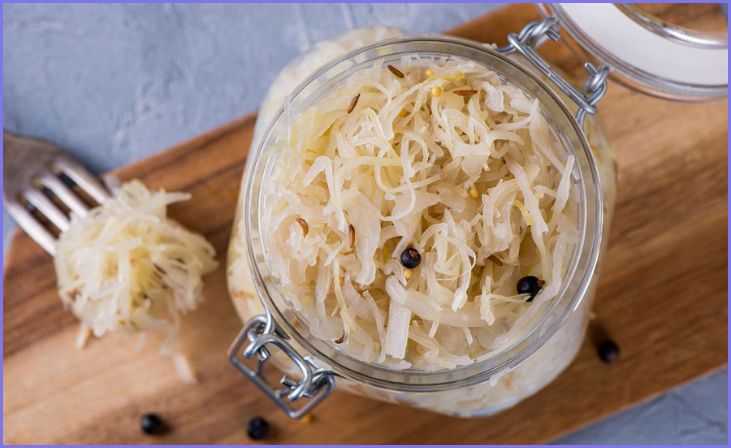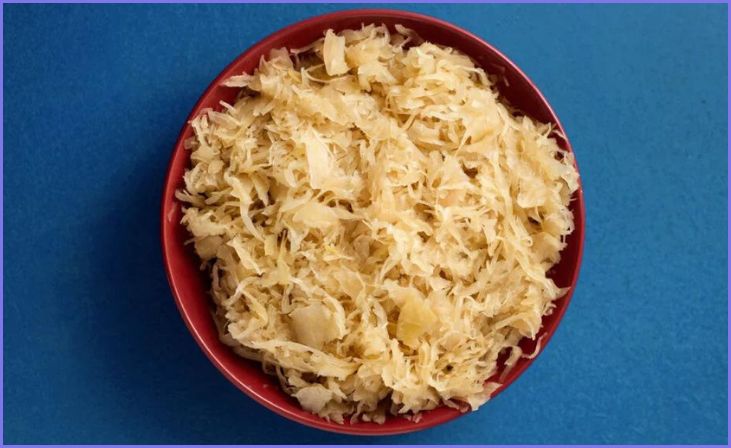How to Make Sauerkraut – Sauerkraut, a tangy and probiotic-rich fermented cabbage dish, is not only a culinary delight but also a nutritional powerhouse. Making sauerkraut at home is a rewarding and straightforward process that requires just a few key ingredients and a bit of patience.
This guide outlines a six-step method to create your own batch of homemade sauerkraut, emphasizing simplicity and ease. From selecting the right cabbage to achieving the perfect salt-to-cabbage ratio, each step is designed to demystify the fermentation process.
By following these clear instructions and utilizing basic kitchen equipment, you’ll soon have a jar of flavorful sauerkraut ready to enhance your meals and support your gut health. Join the ranks of home fermenters and unlock the culinary joy of crafting your own probiotic-packed sauerkraut in the comfort of your kitchen.
Importance of homemade sauerkraut

Homemade sauerkraut holds several advantages that make it a compelling choice for those seeking a flavorful and health-conscious addition to their diet:
- Nutritional Superiority: Homemade sauerkraut retains more of its nutritional value compared to commercially processed alternatives. The live cultures present in homemade versions contribute to a richer array of probiotics, fostering a healthier gut microbiome.
- Control over Ingredients: Crafting sauerkraut at home allows you to control the quality of ingredients. You can choose organic cabbage, high-quality salt, and any additional flavors, ensuring a more wholesome and chemical-free final product.
- Customization: Homemade sauerkraut is incredibly versatile. You can experiment with different varieties of cabbage, add herbs, spices, or even incorporate other vegetables to create a personalized flavor profile that suits your taste preferences.
- Cost-Effective: Producing sauerkraut at home is often more cost-effective than purchasing specialty brands, especially when making larger batches. This cost efficiency encourages regular consumption, promoting overall well-being.
- Preservation of Enzymes: The fermentation process in homemade sauerkraut preserves enzymes that aid in digestion. These enzymes can contribute to improved nutrient absorption and overall digestive health.
- Reduced Additives: Commercially produced sauerkraut often contains preservatives and additives for extended shelf life. Homemade versions eliminate the need for such additives, promoting a cleaner and more natural end product.
Also, Read – Most Popular Chicken Dinners
How to Make Sauerkraut in 6 Simple Steps
Making sauerkraut at home is a simple and rewarding process. Sauerkraut is a fermented cabbage dish that is not only delicious but also rich in probiotics. Here’s a basic recipe to make sauerkraut in six simple steps:
Ingredients:
- 1 medium-sized cabbage (green or red)
- 1 tablespoon of salt (non-iodized)
- Optional: caraway seeds, juniper berries, or other flavorings of your choice
Equipment:
- A large mixing bowl
- A sharp knife or a mandolin
- A clean quart-sized glass jar or a fermentation crock
- A weight (like a smaller jar filled with water) to keep the cabbage submerged
- A clean cloth or coffee filter to cover the jar
- Rubber band or string to secure the cover
How to Make Sauerkraut in 6 Simple Steps
Prepare the Cabbage

Quarter and core a medium cabbage, then thinly slice or shred it. In a large bowl, sprinkle 1 tablespoon of non-iodized salt over the cabbage. Massage the cabbage for 5-10 minutes until it becomes limp and releases liquid. Optional: add caraway seeds or juniper berries for flavor.
Pack the shredded cabbage tightly into a clean quart-sized glass jar, pressing it down. Ensure the cabbage is submerged in its liquid.
Place reserved cabbage leaves on top and use a weight to keep the cabbage submerged. Cover the jar with a cloth, secure with a rubber band, and ferment at room temperature for 1-3 weeks. Check and press down as needed.
Add Salt
For homemade sauerkraut, start with a medium cabbage. Quarter, core, and thinly slice the cabbage. In a large bowl, sprinkle 1 tablespoon of non-iodized salt over the cabbage. The salt acts as a natural preservative and kickstarts the fermentation process.
Massage the cabbage for 5-10 minutes until it becomes limp and releases its natural juices. Optionally, add caraway seeds or juniper berries for extra flavor. Pack the salted and flavored cabbage tightly into a clean quart-sized glass jar, ensuring it’s submerged in its liquid.
Top with reserved cabbage leaves and use a weight to keep it all submerged. Cover with a cloth, secure it, and let it ferment at room temperature for 1-3 weeks. Regularly check and press down as needed.
Massage and Mix
After salting the shredded cabbage, the next step is crucial: massage and mix. With clean hands, knead and squeeze the cabbage for 5-10 minutes. This action softens the cabbage, breaks down cell walls, and encourages the release of its natural juices.
As you massage, you’ll notice the cabbage becoming more pliable and the liquid pooling at the bottom of the bowl. This process ensures that the cabbage is well-coated in its brine, creating an environment conducive to fermentation.
Take the time to thoroughly massage and mix, setting the foundation for a flavorful and properly fermented sauerkraut.
Also, Read – Casserole Recipes for Effortless Dinners
Add Optional Flavors

Enhance your sauerkraut’s flavor by incorporating optional ingredients. After massaging the cabbage, consider adding caraway seeds, juniper berries, or other preferred seasonings. These optional flavors contribute depth and complexity to the final product.
Sprinkle them into the shredded cabbage and mix well to distribute the flavors evenly. Experiment with quantities based on personal preference, keeping in mind that these additions will infuse their essence during the fermentation process.
This step allows you to customize your sauerkraut, creating a unique blend of tastes that suits your palate. The infusion of additional flavors adds a delightful twist to the traditional fermented cabbage dish.
Pack the Jar
Pack the prepared cabbage tightly into a clean quart-sized glass jar, ensuring there are minimal air pockets. Use a utensil or your hands to press the cabbage down firmly. The goal is to eliminate any gaps and submerge the cabbage in its own liquid.
This liquid, now enriched with salt and optional flavors, is crucial for the fermentation process. Continue packing until the cabbage is below the jar’s neck.
To further aid in submersion, place reserved outer cabbage leaves on top. Lastly, add a weight, such as a smaller jar filled with water, on the cabbage to keep it submerged. This compression promotes an anaerobic environment ideal for fermentation.
Ferment

Cover the packed jar with a clean cloth or a coffee filter secured with a rubber band. This allows gases to escape while preventing contaminants from entering. Set the jar in a cool, dark place at room temperature, away from direct sunlight.
The fermentation process will take about 1-3 weeks. During this period, check the sauerkraut regularly, pressing the cabbage down if it rises above the liquid. Taste after the first week and continue fermenting until the desired tanginess is achieved.
The longer the fermentation, the more intense the flavor. Once satisfied, store the sauerkraut in the refrigerator to halt the fermentation process. Enjoy the homemade goodness!
Conclusion
In conclusion, crafting your own sauerkraut at home not only elevates your culinary experience with a personalized touch but also offers a spectrum of health benefits.
From supporting a robust gut microbiome to providing a cost-effective and additive-free option, homemade sauerkraut stands as a testament to the rewarding simplicity of fermentation.
Embrace the joy of creating this tangy delight in your kitchen, savor the unique flavors, and relish the holistic well-being that comes with each delicious bite. Cheers to the art and science of homemade sauerkraut!
FAQs
A fermentation container is recommended for its airtight seal, but alternatives like glass jars with tight lids can be used. Ensure proper packing and a secure covering.
Look for bubbles, a sour aroma, and changes in color. Taste a small amount after a few days. If it’s tangy and has the desired texture, it’s likely fermenting well.
Yes, you can adjust the salt level to taste. However, be cautious, as too little salt may result in spoilage, and too much can hinder fermentation.







